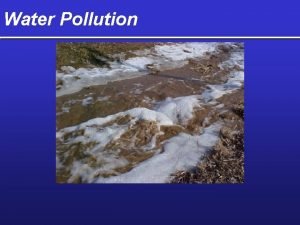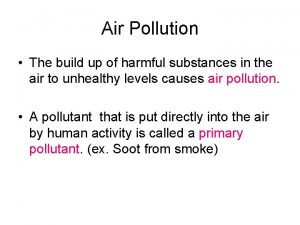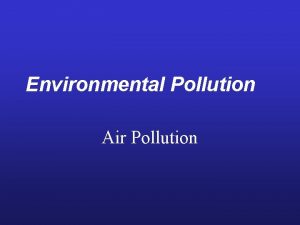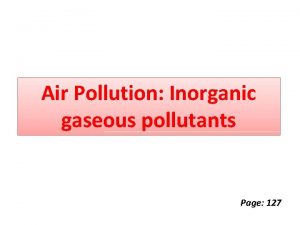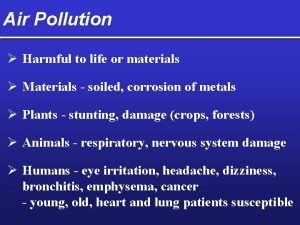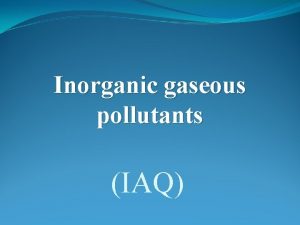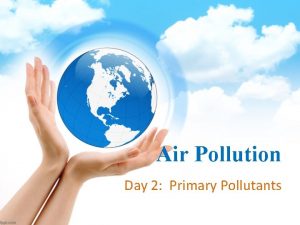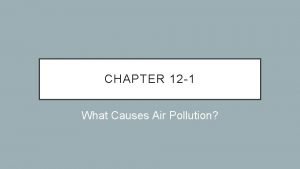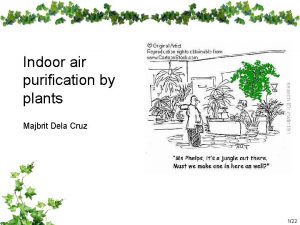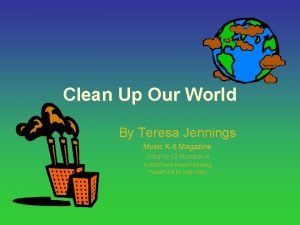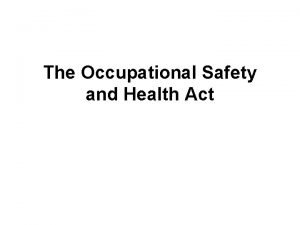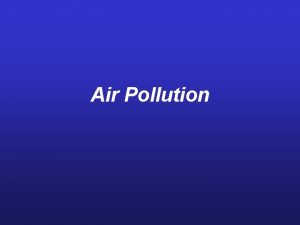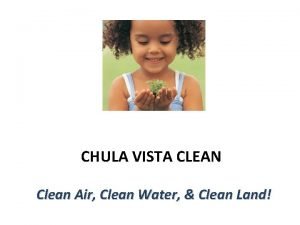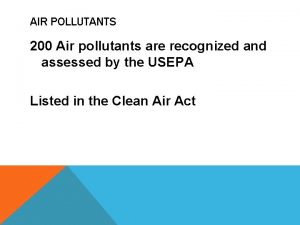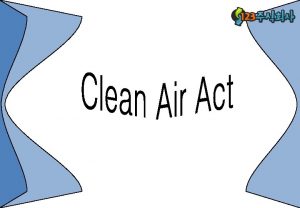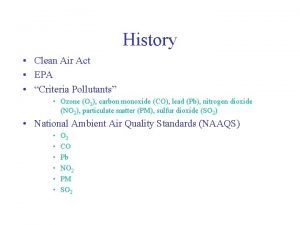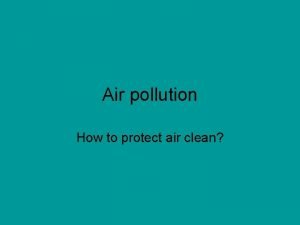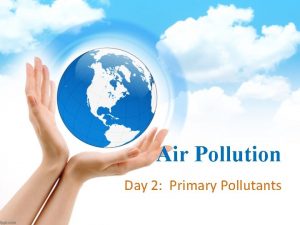Major Air Pollutants Clean Air Act 1970 6













- Slides: 13

Major Air Pollutants

Clean Air Act 1970 ● 6 pollutants that significantly threaten human well-being, ecosystems, and/or structures. ● Called criteria pollutants, each has specified allowable concentrations set by the EPA 1. Sulfur dioxide (SOx) 2. Nitrogen oxides (NOx) 3. Carbon monoxide (CO) 4. Particulate Matter (PM) 5. Ozone (O 3) 6. Lead (Pb) Other: 1. Volatile Organic Compounds (VOCs) 2. Mercury Carbon Dioxide


Sulfur Dioxide Humans: combustion of fuels such as coal and oil. Natural: Volcanic eruptions (large quantity), forest fires (small quantity) (about 30% of global emissions natural) Harms: Respiratory irritant, harms plant tissue, converts to sulfuric acid in atmosphere (acid rain, acid deposition)

Nitrogen Oxides NO: colorless, odorless gas NO 2: pungent, red-brown gas Transform between the 2 in the atmosphere (78% nitrogen gas) Humans: Cars and fossil fuel combustion Natural: forest fires, lightning, microbe action in soil (About 44% global emissions natural) Harms: forms ozone and photochemical smog

Carbon Oxides Carbon monoxide (CO) is one of the 6 criteria pollutants, carbon dioxide has been proposed to be labeled as a pollutant in the Clean Air Act. In 2009 it was ruled that it would be considered “at some point in the future” CO- colorless, odorless gas formed during incomplete combustion of most matter. Car exhaust. Harmful indoor if poor ventilation when cooking with charcoal, manure, or kerosene. CO 2 - colorless, odorless gas formed during the complete combustion of most matter. Absorbed by plants during photosynthesis, released during respiration.

Particulate Matter (PM) Solid or liquid particles suspended in air. Human: from combustion of wood, animal manure, biofuels, coal, oil, and gas. Diesel gives off more than gas. Comes from road dust and rock crushing. Nature: Volcanoes, forest fires, dust storms PM 10 and PM 2. 5 can cause severe damage to the respiratory system because they are not filtered by nose PM scatters and absorbs sunlight. 1816 year without a summer. Causes reduced visibility.


Photochemical Oxidants Oxides are reactive compounds that remove electrons from other substances. Photochemical oxidants are formed from sunlight acting on nitrogen oxides and sulfur dioxide. There are many types, main focus is ozone (O 3). Can be harmful to respiratory tract and tourism. Enhances the formation of smog. Photochemical- dominated by ozone called, Los Angeles-type smog, brown smog Sulfurous- sulfur dioxide and sulfate compounds called London-type smog, gray smog.

Lead Trace metal that occurs naturally in rocks and soil. It’s in small concentrations in oil and coal. Formerly it was added to gasoline to improve performance. In U. S. phased out as an additive between 1975 -1976. Since then concentration in air has decreased. Lead-based paint is a problem in old buildings. Paint chips can be toxic to the central nervous system.

Volatile Organic Compounds (VOCs) Organic compounds that become vapors at typical atmospheric temperatures. Many are hydrocarbons (carbon-hydrogen bonds); gas, lighter fluid, dry cleaning fluid, oil-based paints, and perfumes. Usually have a strong aroma. *Play an important role in the formation of ozone. Not necessarily dangerous, released by conifer trees. Ethylene, terpenes (fragrant smell of conifers and citrus). (VOCs are 89% natural emissions) Not considered criteria, but lead to the formation of photochemical oxidants so they have the potential to be harmful.

Primary and Secondary Pollutants Primary- direct from smokestack, exhaust pipe, or natural emission source. CO, CO 2, SO 2, NOx, most particulate matter, many VOCs Secondary- primary that underwent transformation in the presence of sunlight, water, oxygen, or other compounds. Occurs faster during the day and in wet environments. Example= Ozone (NOx and VOCs in sunlight), sulfates, nitrates.

 Primary pollutants and secondary pollutants
Primary pollutants and secondary pollutants Primary pollutants and secondary pollutants
Primary pollutants and secondary pollutants How are primary and secondary pollutants different
How are primary and secondary pollutants different Major air pollutants
Major air pollutants Inorganic gaseous pollutants of air
Inorganic gaseous pollutants of air What is secondary pollutant
What is secondary pollutant Inorganic gaseous pollutants of air
Inorganic gaseous pollutants of air What are the secondary air pollutants
What are the secondary air pollutants Air pollutants
Air pollutants Indoor air pollutants
Indoor air pollutants Clean air act of 1990
Clean air act of 1990 Clean air act philippines
Clean air act philippines Clean up everybody let's clean up
Clean up everybody let's clean up Occupational safety and health objectives
Occupational safety and health objectives
